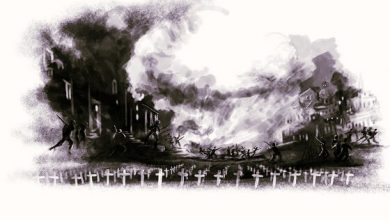Nathaniel Hawthorne‘s ‘Young Goodman Brown’ is a sinister and allegorical short story that explores the themes of sin, temptation, and the inner struggle between good and evil. The novel, which takes place in late 17th-century Puritan New England, chronicles the adventure of a young man named Goodman Brown as he sets out on a terrifying foray into the forest.
Young Goodman Brown | Summary
The story opens with a man called Goodman Brown kissing his wife, Faith, goodbye before leaving for a journey. He assures her that he will be back before the sun rises. Faith pleads to him to not go on a journey tonight. She is afraid of her dreams and fears, and being alone with them, especially that night. However, her husband insists on the completion of an important task which has to be completed that very night. He asks him to not doubt her after being married for three months, and she sends him off wishing for his safe return.
As he walks away he feels saddened to leave his poor wife alone who appears melancholic despite the bright pink ribbon she dons. He promises himself that after tonight he will resolve his struggle and faithfully follow his wife to the end. As Goodman Brown ventures further into the forest treading a lonely and dreary path, he encounters an older man, whom he recognizes as his fellow townsman, the Devil who repudiates him for being late. He tells the devil that his wife held him back for a little while. The Devil asks him to accompany him further. Goodman Brown attempts to resist following his way, arguing that he comes from a noble and faithful family who has never walked in these woods. The Devil speaks of Goodman Brown’s family history and reveals the dark secrets of his ancestors.
Goodman tries to deny what the Devil tells him by asserting that his family belonged to a community consisting of people who believed in God and prayer, and would have ousted his ancestors had they truly been like what the Devil described them as. The Devil, however, offers details of the sins and misdeeds of everyone Goodman Brown had respect for. Goodman Brown meets a female figure on the route during their trek who he recognizes as the pious and admirable woman who taught him his catechism when he was younger. In order to avoid being observed by the woman, he advises that they take a diversion through the woods. As the Devil approaches the woman, touches her with his staff, and exposes his actual identity. The woman recognizes the Devil as a friend, startling Goodman Brown. The Devil uses persuasive reasons to try to persuade Goodman Brown to press ahead and stay on the route as they continue their journey. At one point, Goodman Brown refuses to go any further, questioning why he should leave his beloved wife, Faith.
The Devil offers him his staff and then vanishes into the night, promising him that he will eventually change his mind about completing their quest. Now that he has turned away from his evil intention, he imagines a night of tranquil sleep in the arms of his wife, Faith. He hears horses arriving hears the voices of two riders and observes several town residents, including religious leaders and other notable citizens, taking part in an evil rite. When Goodman Brown sees people he used to know as pious and virtuous, he is horrified.
Goodman Brown calls out for his wife Faith in a state of excruciating pain and anguish, but the forest mockingly repeats his cries. He is terribly uneasy when a pink ribbon that belongs to Faith slowly flutters down and catches on a tree branch and declares that he has lost his ‘faith’. Unable to comprehend the situation adequately, he laughs uncontrollably, clutches his staff firmly, and takes it out again at a frantic pace as he is overcome with anguish. Being unafraid of the other horrors around him, Goodman Brown himself emerges as the central element of horror in the scene.
Goodman Brown continues forward through the darkness until he notices a red light that resembles a fire in a clearing up ahead. He pauses as he hears what sounds like a hymn being sung by the choir of the village meeting house. The resulting silence is broken by Goodman Brown’s cautious approach to the light’s source. He finds a clearing in the thick forest, with a rock that looks like either an altar or a pulpit in its center. Suddenly, a congregation is seen. Goodman Brown comments on the grave and the dark-clad company present, which included faces that would be seen the next day in the provincial council, pious people who were frequently seen in church, as well as men and women renowned for their cries and heinous behavior.
Goodman Brown is concerned about his wife Faith’s presence during this meeting. He feels himself joining them as the hymns continue, and he is beckoned forward by recognizable faces. The Devil addresses the crowd and discusses the strength of evil and how it can infiltrate everything and everyone. Goodman Brown notices his wife there as the Devil commands his disciples to face one another. He tries to persuade his wife to fight the evil as the Devil’s baptism begins, but he quickly falls back and loses consciousness, so he has no memory of what happens next.
Goodman Brown finds himself lying on the ground in the middle of the forest after waking up. It’s still unclear if what he saw actually happened or if it was all in his head. The following morning, he finds his way back to Salem while feeling confused and lost. However, the things he went through in the wilderness have changed him forever. Unable to reconcile the darkness he saw with the outward piety portrayed by his fellow townspeople, he develops into a depressed and suspicious man. He continues to live a harsh and cynical existence, constantly questioning the motives and ethics of others.
Young Goodman Brown | Analysis
Scholars have frequently interpreted the story as Goodman Brown’s journey into the forest symbolizing his loss of innocence and faith. The character’s journey into the forest, the loss of his faith in the world, and its religion and morals, as well as the loss of respect and reverence he had for his wife whom he also sees present at the gathering, are all simultaneous processes. His faith in the fundamental goodness of people is shaken as he observes the corruption and darkness all around him, including the realization that his wife, Faith, is a part of the evil gathering. The story examines how flimsy faith can be and the terrible consequences of losing hope.
The element of his wife’s Faith, being reflective of his own moral and religious faith forms an important point of analysis. The narrative starts off as a typical allegory, setting up the assumption that the characters will continually display the abstractions they stand for, one of which is Faith. It is not tenable to claim that Brown was always predisposed to the despair into which he is thrown because, after giving in to evil and becoming an image of the devil, he regains his calm and calls on Faith once again. But when his attempts to mend his broken relationship with Faith fail, he is left with little choice but to give up. The most horrific part of the story is revealed when he encounters Faith at the gathering of the Devil—the suggestion that she has formed her own independent pact with the Devil. There is a nagging suspicion that her involvement went beyond and went deeper than Brown’s. This change is foreseen when Faith begs her husband to stay with her ‘this night…of all nights in the year.’ Her dreams are connected to his in this way, indicating that they have both mentally prepared for the same experience.
However, there has been subsequent research on the psychological aspects of the story. According to scholars, the narrative consists of all three elements: a dream vision, a traditional allegory, and ultimately, an investigation into the issue of religion that challenges the underlying premises of the allegory. Others have offered an even more nuanced viewpoint, claiming that it is obvious that before Brown had any doubts about the sincerity of ostensibly pious people—that is, before he had entered the forest—he was himself intentionally and knowingly engaging in sin, though with the intention of reforming shortly. Brown’s sin of believing in Satan and developing cynicism is a result and punishment of that transgression. Hawthorne held that every human being has bad impulses, but he did not think that most people are primarily evil or that most people turn a significant amount of their evil impulses into evil deeds. In essence, Hawthorne does not share the black pessimism that Goodman Brown eventually developed as a result of his sin.
Because of his sin, Goodman Brown developed cynicism and believed in the existence of evil where none existed. This isn’t the tale of a man who became demoralized by the realization that many people who profess to be religious and morally upright are actually sinners; rather, it’s the tale of a man whose sin made him believe that everyone else was also a sinner. Brown ultimately learned to evaluate people for themselves, believing that they were hypocritical and wicked because he was. He misjudged them; he didn’t judge them fairly. Despite what Goodman Brown later came to think of them, the Salem Village Minister, Deacon Gookin, Goody Cloyse, and Faith were all wonderful people.
Young Goodman Brown | Themes
‘Young Goodman Brown’ examines the characteristics of evil and how ubiquitous it is. The Devil stands for the personification of evil, while the forest is a metaphor for the untamed and primal part of human nature. The narrative highlights the ongoing conflict between good and evil by implying that evil does not just reside on the outside, but also within each human. Hawthorne poses concerns regarding moral ambiguity and a person’s obligation to resist temptation. The choice between joining the wicked gathering and defying the Devil’s power is put before Goodman Brown. The necessity of making moral decisions for oneself and the results that follow are emphasized in the text.
Faith is a key theme in the narrative, both as a character and as a concept. Faith, Goodman Brown’s wife, stands in for his own belief in kindness and God. He begins to lose trust in her, in himself, and in mankind as a whole. The story raises concerns about the resilience of religion in the face of temptation and uncertainty.
The excursion into the wilderness undertaken by Goodman Brown represents his loss of faith and of his youth. His faith in the fundamental goodness of people is shaken as he observes the corruption and darkness all around him, including the realization that his wife, Faith, is a part of the evil gathering. The story examines how fragile faith can be and the terrible consequences of losing hope.
The idea of sin is intimately related to the theme of temptation. The Devil tempts Goodman Brown to join a wicked meeting where he watches the immoral behavior and sinful deeds of people he had previously held in high regard. The tale examines the conflict between good and evil on a personal level as well as the challenges of restraining temptation in a dishonest society.
The story’s overarching subject of appearance versus truth is clear throughout. Hawthorne contests the idea that people should be judged only based on their looks or public persona. The people in the novel are secretive and act hypocritically, which highlights the discrepancy between their seeming morality and their true selves.
Hawthorne also criticizes the Puritan society’s moral hypocrisy. Underneath Puritan society’s ostensibly pious and religious exterior, Hawthorne criticizes the hypocrisy and hidden evils that can be discovered. Even among those who are regarded as the most pious members of the community, the story demonstrates the moral and spiritual degeneration that prevails.
The story highlights the sharp contrast between the individuals’ concealed vices and misdeeds and their outward appearance of righteousness. It calls into question the validity of religious and cultural institutions and casts doubt on the idea that external religiosity is a true reflection of inner goodness. It implies that everyone has the potential to sin and is subject to temptation, despite their seeming religiosity. It examines the idea of the duality of humanity by showing how each person is constantly torn between good and evil. It implies that everyone possesses a complex mix of virtue and vice rather than being totally pure in either regard.
The subjective aspect of truth and reality is emphasized by Hawthorne himself. As Hawthorn left the conclusion and meaning of the narrative open-ended, the events in the story might be understood as either a true encounter with the devil or as a hallucination triggered by Goodman Brown’s own worries and uncertainties. The validity of perception and the malleability of truth may likewise be called into doubt by this.
Young Goodman Brown | Title
The title ‘Young Goodman Brown’ refers to both the protagonist and his capacity as a symbol. The names used in the title provide meaning and highlight the moral dilemmas that regular people encounter. Irony and ambiguity are introduced by the title as Brown’s journey reveals the darkness underlying his outward appearance of goodness.
Young Goodman Brown | Character Sketch
Goodman Brown: Young and devoted Purita, Goodman Brown sets out on an expedition across the woodland. Though at first naïve and devoted, he gradually develops doubts, suspicions, and a crisis of faith. He loses his innocence and starts to doubt his own and his community’s morals, ultimately standing in for the conflict between good and evil.
Devil: The Devil is a malicious and alluring person in the tale who is also referred to as the black figure or the fiend. He stands for the forces of evil, sin, and temptation. Throughout the story, he assumes a variety of personas, including one that is remarkably similar to a New England church pastor.
Faith: Faith is Goodman Brown’s youthful wife and a representation of his own innocence and faith. She is shown to be a pure and pious woman, and her name emphasizes her unwavering faith in God. For Brown, faith acts as a moral compass, expressing both his spirituality and his connection to his religious community. Her persona poses concerns about the nature of faith and its susceptibility to outside forces.
Young Goodman Brown | Literary Devices
The complete text is written as an allegory. It is symbolic of humanity’s temptation to evil, the journey towards sin, and fragile moralities and religious beliefs. Goodman Brown’s literal journey into the forest is reflective of one’s journey into darkness, solitude and sin. Symbolism is prevalent throughout the story, enriching its themes and deepening its meaning. For example, Faith’s pink ribbons symbolize innocence and purity, which are tainted when Faith becomes involved in the wicked gathering. Goodman Brown frequently refers to them and is distraught upon seeing them in the forest.
‘…But something fluttered lightly down through the air and caught on the branch of a tree. The young man seized it and beheld a pink ribbon. “My Faith is gone!” cried he, after one stupefied moment. “There is no good on earth; and sin is but a name. Come, devil! for to thee is this world given?” And maddened with despair, so that he laughed loud and long…’
The frequent reference to Faith’s pink ribbons is also interpreted as imagery, as it seeks to provide a visual element of Faith’s innocence.
Besides the ribbon, the author also uses imagery to describe the forest, to conjure up images of a dark, dreary, and sinful environment.
‘The whole forest was peopled with frightful sounds; the creaking of the trees, the howling of wild beasts, and the yell of Indians’
He also uses imagery to describe the congregation of the devil.
‘…“surrounded by four blazing pines, their tops aflame, their stems untouched, like candles at an evening meeting… Each pendent twig and leafy festoon was in a blaze”…’
Additionally, the imagery of Faith’s ribbon with that of the forest, used contrast, to highlight the tension between Goodman Brown’s attempt to hold onto his faith and innocence and the alluring temptation of the dark forest. Seeing Faith’s pink ribbons in the dark forest deeply troubles him.
The story also employs foreshadowing. When Goodman Brown is leaving for the forest, Faith wishes for him to stay, as she is fearful of being alone that particular night towards the later events of the night, wherein Faith is also present and scared at the Devil’s gathering.
‘…“A lone woman is troubled with such dreams and such thoughts, that she’s afraid of herself, sometimes. Pray, tarry with me this night, dear husband, of all nights in the year!”…’
Another important literary device is the use of irony in naming the character. The irony lies in the contrast between his name, Goodman, which suggests goodness and purity, and his moral journey into the darkness.




